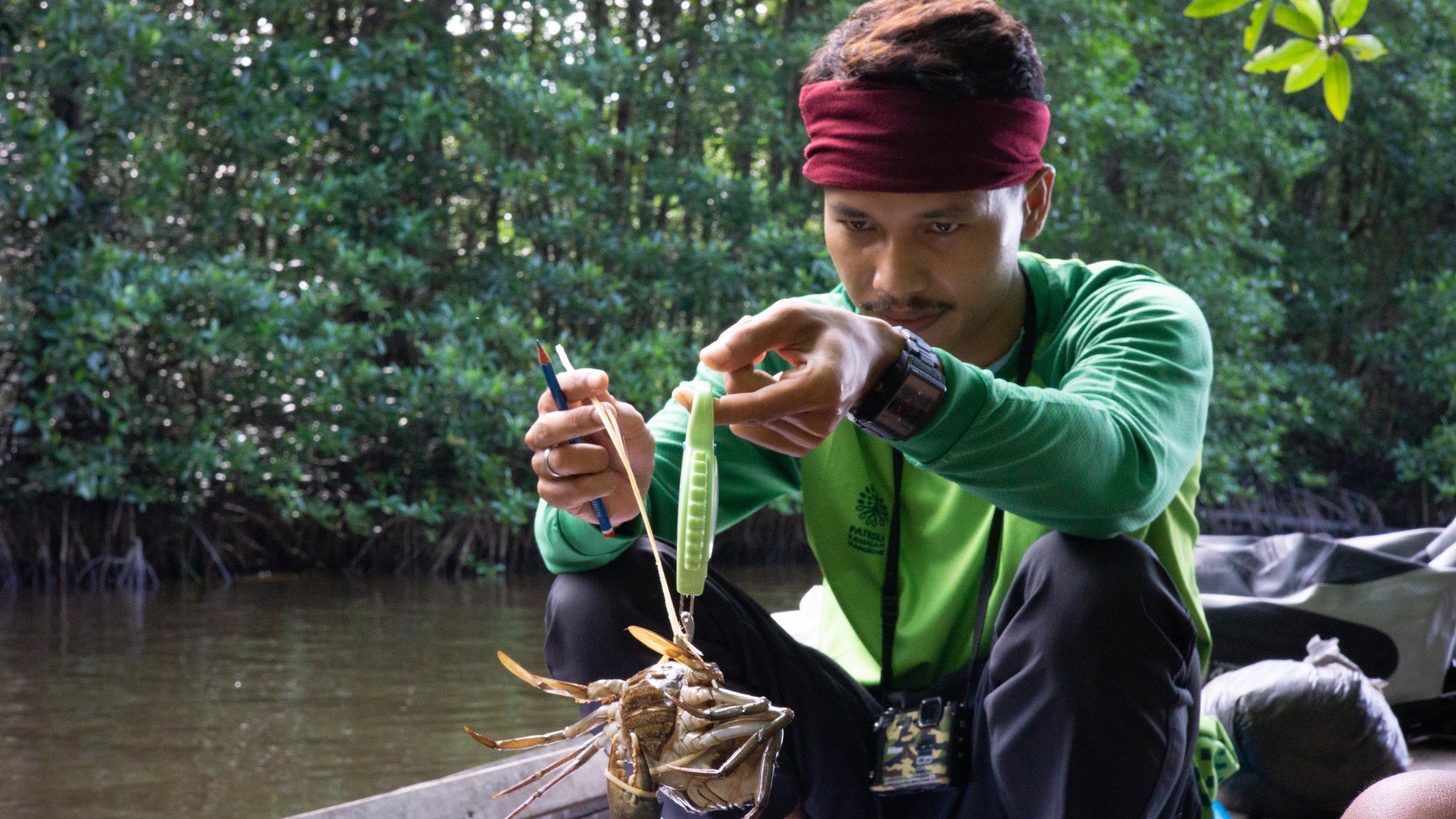Analysis of six years of community-based fisheries management shows positive perceptions but worrying trends.
By Marc Fruitema
Small-scale fishers from Kubu Raya have been actively managing the mud crab fishery since 2017. Since this time, they have implemented around two temporary mud crab fishery closures per year and, in 2019, introduced and established an additional 900 hectares of permanent no-take zones in the mangroves. Combined, these temporary fishery closures and no-take zones are intended to protect key habitats, give mud crabs enough time to grow big, and ensure fishers benefit economically from a healthy and (hopefully) improving fishery! This fishery is economically very important for these six villages, representing somewhere around $150,000 - $300,000 in income per year for all small-scale mud crab fishers. Ensuring its effective management is key to sustaining the small-scale fisher and community livelihoods that depend on it.
The reality is that many fisheries globally are overfished and overexploited. Before we began working with these villages, fishers already shared that they had been catching less than in the past, indicating declining catches as a result of overfishing, ecosystem degradation, or some combination of both. Fishers’ perceptions and knowledge are often an early warning sign of changing conditions in the fishery, so we should pay attention to what fishers are seeing and saying.
Given the decline in many fisheries around the world, there is an urgent need to advance the good governance of small-scale fisheries. For Planet Indonesia this involves securing tenure rights, establishing or strengthening local governance institutions, supporting participatory management planning, and providing access to finance, credit, and savings mechanisms for small-scale fishers and coastal communities.
“Fishers' perceptions and knowledge are often an early warning sign of changing conditions in the fishery, so we should pay attention to what fishers are seeing and saying.”
After six years of working to improve the governance and management of mud crab fisheries in Kubu Raya, West Kalimantan, it was time to take a step back and to assess if there was any observable or measurable change in the state of the fishery. We have attempted to evaluate the short-term impacts of temporary closures before on the size and density of mud crabs, but this time, we wanted to combine all of our fisheries & social data to see in the long term, using some key indicators, whether the mud crab fishery has gotten healthier.
To answer this question, we combined fisheries landings data, mud crab surveys that Planet Indonesia has done over the years and results from our participatory impact assessments. Combined, this would help us understand economically, biologically and socially, to what degree are management objectives for the mud crab fishery being met?
In summary, the results are slightly conflicting. Importantly, this fishery is being governed well at individual village and multi-village levels, and the mean weight of crabs has increased from ~290 grams in 2018 to slightly over ~400 grams in 2023. Through the social forestry licenses, communities have management and access rights, and the individual village forest management institutions oversee the implementation of temporary closures and permanent no-take zones. Rivers and mangrove forests are regularly patrolled, and rules are enforced in accordance with local norms & customs. The neighboring villages also coordinate and synchronize their management initiatives in recognition that fishers from one village also fish in the mangroves and rivers that are managed by other villages. This governance framework ensures coordination and decision-making appropriate to the scale of the mud crab fishery and resource users.
Looking at the fisheries data, catch per fisher per day (kg) and catch per crab pot has increased as has the mean weight of landed mud crabs. This tells us that fishers are catching more per day and per pot, and the mud crabs are getting bigger by weight.
Although the catch and landings indicators are positive, when we looked at the data from the mud crab surveys that Planet Indonesia has done, the results were slightly more concerning. These surveys showed that the mean carapace width for all surveyed crabs from 2021 - 2023, as well as male and female crabs, was around 10 cm. This is important because carapace width is the best-known indicator for identifying the size at sexual maturity of mud crabs. Although there are no studies from Indonesia that identify the minimum size at sexual maturity, the best reference point is 12cm, which is what the government of Indonesia has used to set the minimum size limit (‘Permen KKP No. 16 Tahun 2022’ 2022).
Therefore, the mean carapace width of ~10cm from our surveys in Kubu Raya is well below the minimum size limit set by the government and the best estimate of minimum size at sexual maturity. This means that the average mud crab in Kubu Raya is too young and has not yet had the chance to reproduce. To understand how this compares to mud crab fisheries from other provinces of Indonesia, we looked at similar studies or datasets that were publicly available. A study from North Kalimantan and Maluku Provinces showed mud crabs with a higher mean carapace width of 12cm and 15cm, respectively (Widigdo et al. 2017, Siahainenia et al. 2016). The mean weight of mud crabs, while statistically higher in 2023 at ~400g compared to 2017 roughly ~290g, is still too small and much lower than other parts of Indonesia where the mean weight of mud crabs was ~700g (Siahainenia et al. 2016). This allows us to compare the mud crab fishery from Kubu Raya to fisheries from other provinces of Indonesia and use them as a ‘healthier’ reference point. If the Kubu Raya fishery continues fishing in this way, there is a potential that the fishery will collapse as there are not enough adult-reproducing crabs to replenish the population.
However, during the focus groups for the participatory impact assessments, which Planet Indonesia does every two years, communities identified ‘improved status of the fisheries’ as a key outcome alongside ‘improved environmental protection’ and ‘financial security.’ This presents a conflicting account of the status of the mud fishery where it is delivering against some objectives but not all. Fisheries data shows that fishers are catching more per day on average, but mud crabs are still small, and many are undersized and immature. Fishers and community members nevertheless perceive the fishery to be improving and environmental protection to have increased, alongside financial security. This raises some interesting and challenging questions for us: Is fisher/community perception more important than fisheries surveys? Which data do we listen to when they are saying different things?
Ultimately for us, it is clear that there is an urgent need to engage with fishers on this, share the results of these analyses, and discuss how to proceed. Our role in the governance and management of small-scale fisheries is as a partner and advisor to these communities. Therefore, we have a responsibility to share this data back and provide our recommendations, following which fishers and communities would exercise their agency in determining what to do. In this case, we see the self-enforcement of the minimum size limit of 12 cm carapace width by fishers as a low-cost and easy-to-implement management action that would be priority number one. As larger mud crabs are also worth more, there is theoretically also a clear economic incentive to release undersized crabs and wait until they are above the minimum size limit. As crabs are caught in traps, they are still alive and healthy when brought to the surface by fishers. Simple measurement tools, such as a 12 cm wooden stick or rulers like the ones used in lobster fisheries in the Caribbean, would be easy enough to make and share with fishers. Undoubtedly fishers already know that larger mud crabs are worth more, so we will need to understand what it would take for all fishers and buyers across the six villages to collectively agree to adopt and respect the minimum size limit.
Given the economic importance of this fishery to the small-scale fishers and coastal communities of Kubu Raya, not addressing these warning signs would be a collective failure. Although there are many fish species being caught in these waters, mud crabs are the single largest fishery in terms of value and volume. If the fishery were to collapse or be overfished, these communities would be significantly affected.
Key lessons learned for us:
Nested governance is essential. Working with individual villages is good, but we must nest governance of small-scale fisheries at appropriate and multiple scales to ensure proper coordination and representation of resource users. In the case of Kubu Raya, if single villages managed their forests and mud crab fisheries in isolation, they would exclude fishers from other villages who fish in their forests & rivers. Ensuring nested governance at the multi-village levels is key to ensuring proper consultation and consideration between rights holders and resource users.
The scale of management should ‘fit’ the fishery; Single villages in Kubu Raya would not be able to ensure the effective management of the mud crab fishery. Ecologically and biologically, mud crabs live beyond the boundaries of individual village forests. They are highly territorial; however, they migrate out into the ocean to spawn, and their larvae are distributed far and wide. Therefore the scale of management needs to be large enough that the fishery is being managed at an effective scale.
Quantitative and qualitative data collection is important to be able to evaluate small-scale fisheries management from different perspectives. If we rely on one data source alone, we would get an incomplete picture of the status of the fishery. Just looking at the fisheries data, we don’t consider the broader social, economic, and health-related outcomes that the communities are perceiving and experiencing. Each data source here in Kubu Raya would tell a different and incomplete story.
Fisheries management must balance social, economic, cultural, and fisheries objectives. Ultimately, although fishers may be happy and optimistic about the status of fisheries management if the fisheries data points to potential signs of overfishing, this must be a point for reflection and, hopefully, a call to action for fishers. Likewise, if fisheries data indicated positive signs but fishers perceived catches or income to be dropping, this would be an important point for reflection.
Multidimensional approaches can create the enabling environment for good governance of small-scale fisheries. Access to finance, healthcare, education, and participatory management planning processes are foundational building blocks for the good governance of natural resources.
This work is supported by Blue Action Fund, in partnership with BKSDA, DKP, local communities, and Blue Ventures.
References:
Permen KKP No. 16 Tahun 2022. 2022. Accessed from https://peraturan.bpk.go.id/Home/Details/230457/permen-kkp-no-16-tahun-2022, 2023-6-21.
Siahainenia L, Natan Y, Khouw A, Pattikawa J 2016. Size distribution, growth pattern and condition factor of mangrove crab Scylla serrata in the coastal waters of Western Seram, Maluku, Indonesia.
Widigdo B, Laga A, Hakim A, Wardiatno Y, Rukisah 2017. Carapace length-weight and width-weight relationships of Scylla serrata in Bulungan District, North Kalimantan, Indonesia. BIODIVERSITAS 18.
If you have any questions please reach out via admin@planetindonesia.org. Sign up for our newsletter and follow us on our social media Facebook here, Instagram here, and LinkedIn here to get timely updates on our activities, an insider’s look into the lives of front-line conservationists, and ongoing programs.





